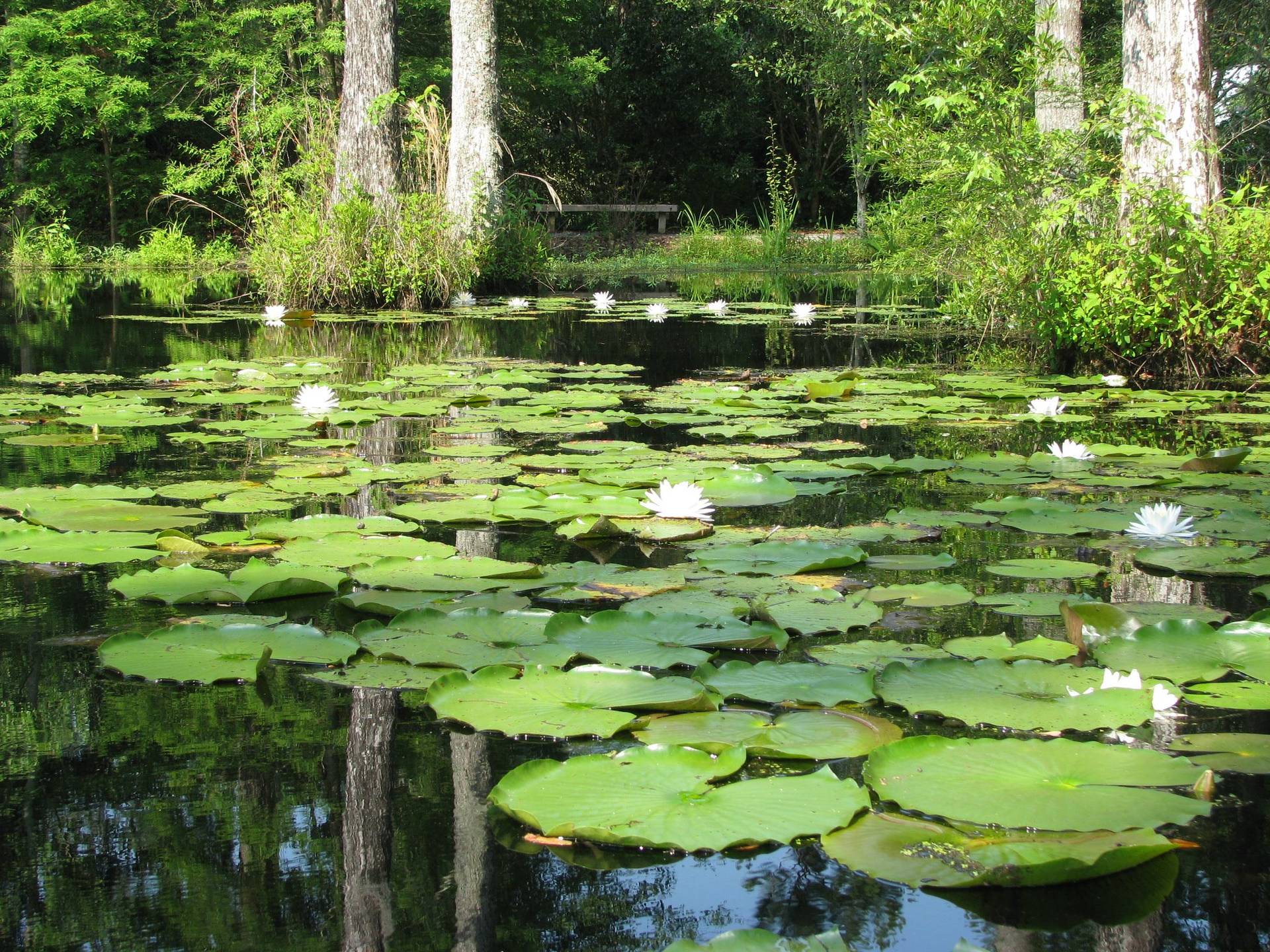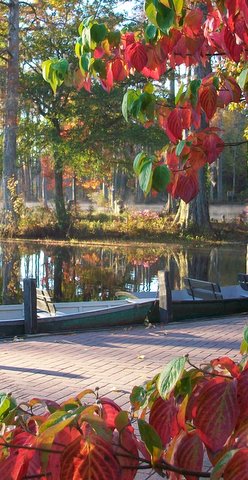Each season offers a different experience at Cypress Gardens.
Common blooms and wildlife seen during each month:
January
Average temperatures range from 20 to 50 degrees Fahrenheit.
- Peak Camellia bloom.
- Alligators may occasionally be seen on sunny days.
- Warm, rainy nights bring choruses from the Spring Peeper and Southern Chorus frogs.
- Brown Creepers and the Orange-crowned Warbler are highlights to see.
- Sunny days may bring the Cloudless Sulfur Butterfly.
- A River Otter may be seen playing in the swamp and winter-nesting Bald Eagles are often sighted overhead.
February
Average temperatures range from 30 to 60 degrees F.
- Daffodils (Narcissus) are at their peak bloom this month.
- The earliest of the spring flowers are blooming:
- Red Maple (Acer rubrum)
- Blueberries (Vaccinium)
- Redbud (Cercis canadensis)
- Yellow Jessamine (Gelsemium sempervirens), the SC State wildflower.
- Yellowbelly Slider and Florida Cooter turtles emerge from their short hibernation.
- The vocals of the Southern Leopard and Green Frogs begin by month’s end.
- Moths such as the Luna Moth and Clear-winged Sphinx and butterfly species, Sleepy Orange, Mourning Cloak and Snout may be seen.
March
Average temperatures range from 40 to 70 degrees F.
- The peak Azalea bloom arrives by months end.
- Blooming wildflowers include:
- Atamasco Lily (Zephyranthes atamasco)
- Coral Honeysuckle (Lornicera sempervirens)
- Crossvine (Bignonia capreolata)
- Violets (Viola)
- Big Floating Bladderwort (Utricularia inflata)
- Sweetleaf (Symplocos tinctoria)
- Jack-in-the-Pulpit (Arisaema triphyllum)
- Blue Toadflax (Linaria canadensis)
- Deciduous trees and shrubs leaf out, including the Bald Cypress (Taxodium distichum).
- The last flowers of the winter-blooming Camellias melt away with the seasonal changes.
- Cricket frogs begin vocalizing.
- This is the onset of breeding season for most birds including:
- Yellow-throated Warblers, Red-shouldered Hawks, Blue-gray Gnatcatchers, Carolina Chickadees, Tufted Titmice.
- Early avian spring arrivals include:
- Purple Martins, Rough-winged Swallows, Summer Tanagers, Parula Warblers, Chimney Swifts.
- Butterflies:
- Black Swallowtail, Little Wood Satyr, Viceroy, Pearl Crescent, Buckeye, Red-spotted Purple, Monarch, and Carolina Satyr butterflies appear along with the earliest of many dragonfly species.
April
Average temperatures range from 40 to 70 degrees F.
- Dogwoods (Cornus) are blooming.
- April is the best time to see native Iris blooming.
- Additions to the March collection of blooming wildflowers include:
- Southern Blue Flag (Iris virginica)
- Dwarf Azalea (Rhododendron atlanticum)
- Southern Arrowwood (Viburnum dentatum)
- Tulip Tree (Liriodendron tulipifera)
- Water-spider Orchid (Habenaria repens)
- The numbers of bird species peak when many of the winter residents will not migrate north usually later in the month or early in May. This winter residents include:
- Ruby-crowned Kinglets
- Hermit Thrushes
- Solitary Warbler
- Yellow-bellied Sapsuckers
- Dark-eyed Juncos
- Swamp Sparrow
- Song Sparrow
- White-throated Sparrow
- Fox Sparrow
- Field Sparrow
- Spring migrants are arriving from their wintering areas which include:
- Prothonotary Warblers
- Hooded Warblers
- Red-eyed Vireos
- Yellow-throated Vireos
- Ruby-throated Hummingbirds
- Wood Thrushes
- Blue Grosbeaks
- Great-crested Flycatchers
- Indigo Buntings
- Orchard Orioles
- Frogs vocalizing in the swamp swells with the added voices of Bulls, Pigs, Little Grass, and Southern Toads.
- Gray squirrels are actively nesting and Bobcat activity soars.
- Though heard throughout the year, Barred Owls are particularly vocal.
- Tiger Swallowtail, Red Admiral, and Spring Azure butterflies make their appearance.
- The last week of April marks the end of peak Azalea bloom.
May
Average temperatures range from 50 to 80 degrees F.
- Antique Roses start to bloom.
- The last of the wintering bird species depart for their breeding grounds, while the last of our breeding species; such as the Painted Bunting arrive.
- Deciduous plants have all fully leafed-out, and more species add their flowers to the landscape, such as:
- Meadow-beauty (Rhexia)
- Lizard-tail (Saururus cernuus),
- Pickerelweed (Pontederia cordata),
- Southern Magnolia (Magnolia grandiflora),
- Trumpet Creeper or Cow-itch (Campsis radicans),
- Water Primrose (Ludwigia uruguayensis)
- Verbenas (Verbena brasiliensis, V. bonariensis)
- Additional frog vocals include Green, Gray, and Squirrel Treefrogs.
- Question Mark butterflies appear.
- Day Lilies begin blooming by months end and continue throughout the summer.
June
Average temperatures range from 60 to 90 degrees F.
- June brings the earth-shaking bellows of the territorial, breeding alligator and the vocals of Narrowmouth Toads.
- Few spring wildflowers remain in bloom, but in their wake come the blossoms of the:
- Fragrant Water Lily (Nymphaea odorata)
- Beauty-berry (Callicarpa americana)
- Blazing Stars (Liatris)
- Crested Fringed-orchid (Habenaria cristata)
- Ironweed (Vernonia acaulis)
- Swamp Rose Mallow (Hibiscus moscheutos)
- Button-bush (Cephalanthus occidentalis)
- Yellow-eyed Grass (Xyris)
- With the increasing heat, birdsong rather steadily decreases while insect song, like the buzzing of cicada, increases.
- Hairstreaks, especially the Gray and the Red-banded, become more prevalent among the butterflies.
July
Average temperatures range from 70 to 90 degrees F.
- More flowering plants appear in the form of:
- Elephant-toes (Elephantopus tomentosus)
- Mistflower (Eupatorium coelestinum)
- Water Willow (Decodon verticillatus)
- Fragrant Ladies-tresses (Spiranthes odorata)
- Other than Mockingbirds, most songbirds have nests of fledglings and are relatively quiet.
- Until colder weather arrives in a few months, the sound of insects is dominant including the Katydid.
- The Palamedes Swallowtail is regularly seen.
August
Average temperatures range from 70 to 90 degrees F.
- Wildlife, other than Insects (Katydids, Cicadas, grasshoppers, crickets) is relatively quiet as another breeding season winds down.
- Early fall bird migrants are becoming apparent and we begin to see the Eastern Kingbird, Barn and Rough-winged Swallows, and flocks of blackbirds and grackles assembling to build into their winter conglomerations.
- Butterfly migrants and wanderers become more common, such as Gulf Fritillaries, Hackberry Butterfly, Cloudless Sulfur, Monarchs, and American and Painted Ladies.
- Composites increase their dominance among flowering plants with at least 8 species of white-flowered Eupatorium, Goldenrods (Solidago), and Lobelias including Purple Lobelia (Lobelia elongata), Glandular (L. glandulosa), and Downy (L. puberula).
September
Average temperatures range from 60 to 80 degrees F.
- Fall migration for birds is apparent as the mixed blackbird and grackle flocks continue to grow in number; Solitary Sandpipers, Palm and Black and White Warblers pass through; and the numbers of Gray Catbirds build to spend the winter.
- Gone until spring are the:
- Yellow-throated Vireo
- Acadian Flycatcher
- Great-crested Flycatchers
- Northern Parula
- Eastern Kingbird
- Purple Martin
- Yellow-throated Warbler
- Summer Tanager
- Blue Grosbeak
- Composites continue to rule the flowering plants including:
- Bur-marigold (Bidens laevis)
- Climbing Aster (Aster carolinianus)
- Goldenrods (Solidago)
- Antique Roses bloom again by months end.
October
Average temperatures range from 40 to 70 degrees F.
- This is the prime fall month for observing the leaf-color change in deciduous plants and trees. The needles of our only deciduous conifer, the Bald Cypress, turn rust-brown.
- Many of September’s composites continue to flower, but most have gone to seed.
- A few amphibians, such as the Ornate Chorus Frog, gear up for their fall and winter breeding season.
- Great-horned and Screech Owls are more vocal.
- Bird migration continues as Red-eyed Vireos and Indigo Buntings will soon vanish until next spring.
- Winter arrivals include the:
- Pied-billed Grebe
- Eastern phoebe
- House Wren
- Winter Wren
- Golden-crowned Kinglet
- Ruby-crowned Kinglet
- American Robin
- Song Sparrow
- Yellow-rumped Warbler
- White-throated Sparrow
- Butterflies remain plentiful and the striking Purple Hairstreak is notable.
November
Average temperatures range from 30 to 60 degrees F.
- Deciduous plants continue to become bare of leaves, including the Bald Cypress.
- The extensive old plantings of Camellias (mostly from Japan) begin to flower.
- Winter resident bird species continue to arrive, such as the:
- Hermit Thrush
- Cedar Waxwing
- Pine Siskin
- American Goldfinch
- Dark-eyed Junco
- Chipping Sparrow
- American Woodcock
- Brown Creeper
- Insect activity is slowing.

December
Average temperatures range from 30 to 60 degrees F.
- The fragrant Tea Olive (Osmanthus fragrans) begins to fill the air along the trails and will last until February.
- Camellias continue to bloom as well as the horticultural Paper White Narcissus flower.
- Swamp Sparrows and other late resident birds arrive.
- Warmer days may bring out surprise butterfly appearances of Gulf Fritillaries, Cloudless Sulfurs, or Monarchs.

